posted: 2025-08-11
A Cat in Super Metroid!?!
Hey.
Hey you.
Do you like Metroid?
Oh you do?
Do you like cats? Cute little kitties? Maybe even some I can has Cheezburger lolcat memes?
Oh you like them too?
Hey. Wouldn’t it be crazy if you had a cat in Metroid?
Someone should make something like that, that would be sick, right?
Hey.
Guess what.
You’re not going to believe this.

You just know they wanted to name this Meowtroid
Gato Roboto is an action exploration platforming video game (dare we call it a Metroidvania) developed by Doinksoft 1, published by Devolver Digital Inc., and released for Windows and Nintendo Switch on May 30, 2019. The player assumes the role of Kiki the Cat, and explores a hostile planet within and without a military-grade mechanically weaponized suit of armor in search of means to repair her human partner Gary’s ship after the two of them crash their spaceship while responding to a distress signal from a planet at with coordinates 42069 2. This detail about the planet’s coordinates may seem trivial, and it is! It’s served up to the player within 30 seconds of booting up a new save file! With this specific numerolgical choice, Gato Roboto’s tone is immediately apparent: Gato Roboto is a little too self-aware.
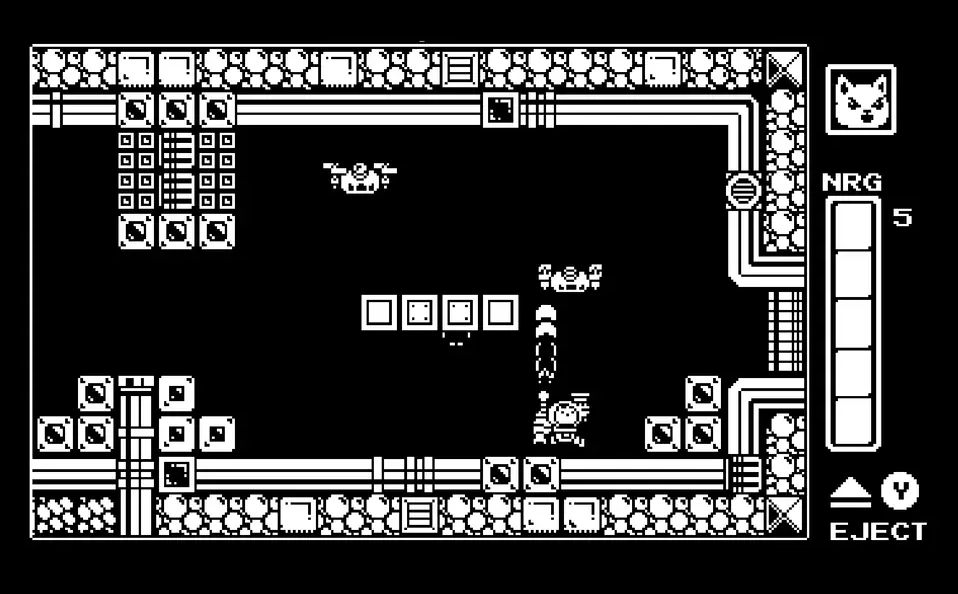
This isn’t to imply Gato Roboto insists upon itself as some new addition to the canon of the Metroidvania genre. Rather, Gato Roboto is acute in its understanding of what makes the genre itself so appealing. Gato Roboto’s design follows the progression seen in many different entries in the genre, the most obvious of these design influences no doubt being Super Metroid. To explain what I mean, let me describe the first fifteen minutes of the game. Within the first directional button presses, the player will determine that Kiki the Cat has cat momentum- that is to say, she hops around and has a kind of horizontal movement physics that feels appropriately cat-like. She runs off of ledges with a slight amount of forward momentum, as if leaping. She can climb walls with the player’s corresponding mash the jump button while in contact with a wall. The player will quickly get a feel for the agile, imprecise nature of the movement in the first few rooms of the game. Thankfully, there are no foes in Kiki’s immediate path forward. This is a crucial detail, as Kiki will otherwise die in a single hit.
As the player moves through the first few rooms and learns how to move around as Kiki, they may enter a suspiciously empty room with a suspicious similarity to the destroyed Mother Brain room in Super Metroid. The space is empty, with minimal sound. The walls in the middle of the room create a bottlenecking effect akin to those seen in the room design from Tourian. After the player exits this room from the right door, they’ll find the aforementioned weaponized mechanical suit in a safe environment in which to do some simple “bonking around”. The player will immediately notice the comparatively weighty feeling from walking and jumping around the space. They’ll learn how far their beam fires from shooting doors. They might even learn that there’s a sense of recoil momentum from firing a missile while in the air. But most importantly, they’ll learn that Kiki is now able to take a few hits before dying.
As the player then retraces their steps in their new outfit, the world springs to life. Like with Super Metroid, the previously-empty Tourian-like room is now crawling with foes that must be destroyed. These foes are arranged such that if the player hadn’t learned about the missile recoil, the will as they try to jump and shoot. And each of these two encounters are each separated by this bottlenecked room, much like Super Metroid’s initial encounter with the Space Pirates. Gato Roboto is not hiding how it has lifted this exact style of tutorial from Super Metroid, down to the shape and size of the rooms where the first enemies are encountered.
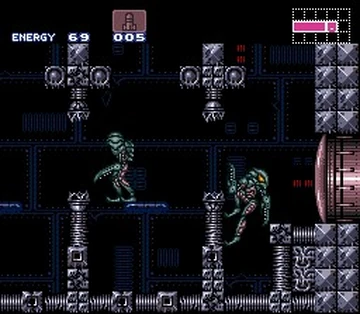
See what I mean?
With these encounters, the player will immediately understand the duality of Gato Roboto. The mechsuit is clunky. The mechsuit cannot traverse water. The mechsuit can only jump a fraction of the height Kiki. This last fact makes the proceeding ascent through a once easily navigable room quite the ordeal. You have to jump up staircase one block at a time. This contrast is what sets Gato Roboto apart from other games like it; there are really two different modes of play in Gato Roboto that the player will have to navigate with similar levels of skill. My favorite parts of this duality came in rooms in which I had to find a way to bring my mechsuit across a waterlogged room by having Kiki swim, bouncing back and forth between the two different kinds of play. This is where Gato Roboto shines as its own game: the differences between these two modes of play make the other more distinct, giving Gato Roboto as sense of place in the genre.
Of course, it’s the mechsuit getting all the power-ups; Kiki the Cat does not get any injectable proteins to make her some kind of superkitty (that’s what the mechsuit is for!). And of course, the mech suit gets all the upgrades one might expect any kind of space-marine type to get: A second jump that allows the player to bounce off of enemies, a phase shifter that lets the player bypass vertical obstacles, and, of course, health and missile upgrades. I don’t mean to admonish the game for leaning into the tropes of the genre here, rather I want to re-emphasize that Gato Roboto knows what makes the Metroidvania genre click. It knows that the best feeling in the world when playing a Metroidvania is when you are fully powered up, and can stunt on every simple stooge that made the mistake of meandering around a miniscule Metroid-like. While a later upgrade to the basic shot ultimately trivializes most rooms, I can’t deny that I had fun just sitting back holding the “fire” button and letting enemies take hit after hit after hit. Dare we call it a power fantasy, I was having a ball. I think it’s when I was fully powered up that I felt that this game was at its most amusing: “haha look at this little kitty ripping through foes like it’s fucking nothing dude”.
The journey to reach this stage was less engaging. I speak from the perspective of someone who happens to have a life-long obsession with mazes, so please take my opinion with the appropriate quantity of salt when I say that Gato Roboto’s world leaves a lot to be desired. For one, the progression through each area is hardly one where anyone might get lost. I don’t think “getting lost” is ever the point in any modern Metroidvania game, but I found that in this regard Gato Roboto shared its design with another Metroid game: Mercury Steam’s: Metroid: Samus Returns 3. Rooms will pull you out to an edge of the map with some kind of trinket or task, and then have passages that immediately return you back to some kind of hub room. With each point of interest, these hub rooms will change in a subtle manner, thus guiding you towards the next point of interest. All these Metroidvania Youtubers might laud this design for “minimizing backtracking”, but I think there’s a fine line between “minimizing backtracking” and straight up being linear.
I must also point out that being a linear Metroidvania game is hardly a detriment top the experience (see Metroid Fusion, and dare we say Castlevania: Symphony of the Night), especially when the zones that you traverse are interesting and memorable. This unfortunately leads us to a problem intrinsic to Gato Roboto: there are very few distinct rooms. This is not a slight against Gato Roboto’s visual style, but rather an unfortunate by-product of the artistic decision to make the game made up exactly two colors and only scroll in one direction per room. While the tiles vary per zone, which could be used for distinguishing purposes, most of the room-to-room traversal in each respective zone never felt distinct in the same way that going between sections the regions in Hollow Knight or the sectors of Metroid Fusion. If you asked me to match a room to its respective zone and “anonymized” the tiles, I could not do it (save for the ventilation levels where you must navigate many rooms with narrow hallways in a row solely as Kiki). And it’s not like this is an unfair assessment, the original Metroid, while colorful, manages to have rooms and set pieces that are distinct enough to clearly identify which zones they belong to. When this issue is combined with the notion of constant forward progress mindset over multiple areas, what results is a generally unmemorable set of challenge boxes that, once navigated, do not require a second thought. It becomes predictable, which is generally the antithesis of any kind of exploration game. At least moving through the rooms is fun enough.
But, see, Gato Roboto is self-aware. It knows how cool it is to move through rooms with mechanical beauty and super-powered grace. But by having this understanding it invokes the paradox of cool: you cannot be cool while also flaunting how cool you are. I find Gato Roboto’s sense of personality all a bit too forced. There’s a consistent effort in the writing to remind you that “wow! you’re a kitty! you’re doing so well for an otherwise helpless animal!”. It’s a fun bit at first. It is amusing to learn that, in an amusing twist of fate, your primary antagonist is a mouse. But by the third interaction where Gary posits something to the effect of “what is that mouse doing? A mouse can’t do that!”, it all grows a bit tiresome. Are we not playing the same game where a cat is in a giant robot suit? The rules are out the window, Gary.
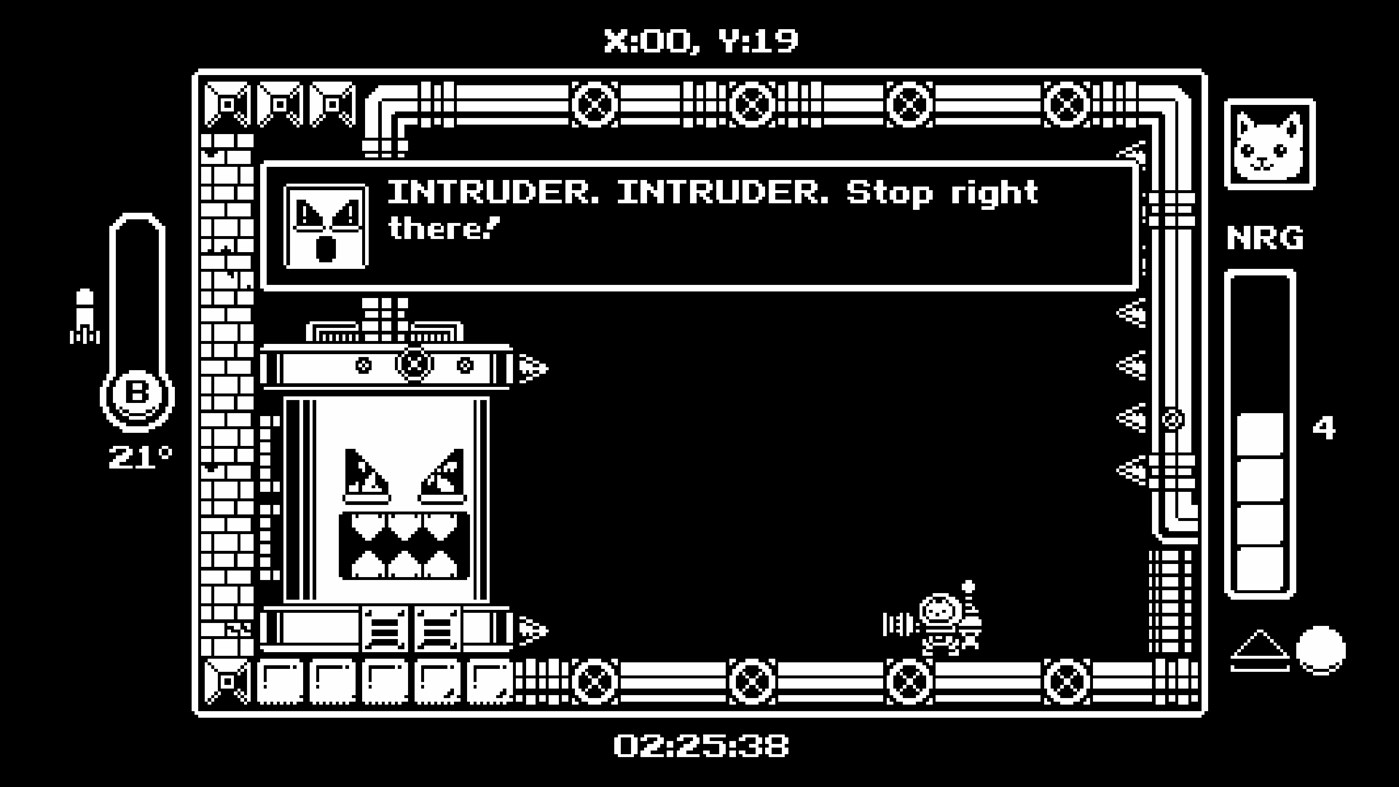
And look, I love a good non-sequitur. I think it’s wonderful to have the flow of conversation get derailed by the verbal equivalent of a cat-shaped asteroid smashing your mom’s platypus. The notion of unexpected and confusing occurrences has defined my sense of humor, from watching a man turn into a chimp after falling into a vat of de-aging serum (Dirty Work, 1933) with my grandfather as a child, to the lolrandom epic bacon narwhal waffle unicorn katy t3h penguin of d00m-style internet posting of my preteens, to an appreciation for dry MacDonald-esque anti-humor in my early twenties, to my obtuse “vocabulary unfit for scientific writing” 4 which I utilize today.
Yet, when I encountered the second animated furnace boss in the Heater Core, I groaned. Let me explain the joke (therein stealing the comedy and worsening my point, whatever). To progress through the second primary zone, the Heater Core, I had to destroy furnaces which were overheating the area, making the space inhospitable for Kiki outside of her suit. The first furnace boss was a simple character: a quirky living furnace. Sure. Okay. After killing it, I progressed through until I found the second furnace sporting a mustache. This second furnace, the first furnace’s brother, wailed about, lamenting that his brother would never know the joy of growing a mustache because we killed him. Sure? Okay? Like, I understand that there needed to be a way to visually define these two different bosses, and the silly thing to do would be to put a mustache on the second one. But this joke just fell so flat, I wondered if it was even supposed to be a joke. I was then expecting to find a third furnace boss as comedy and video games both regularly adhere to the rule of threes. But that was it. There was no third bit. So then why? the only thing I can think of was that they were trying to force a quirky joke. And, as any former middle school student can tell you, a forced joke is never funny.
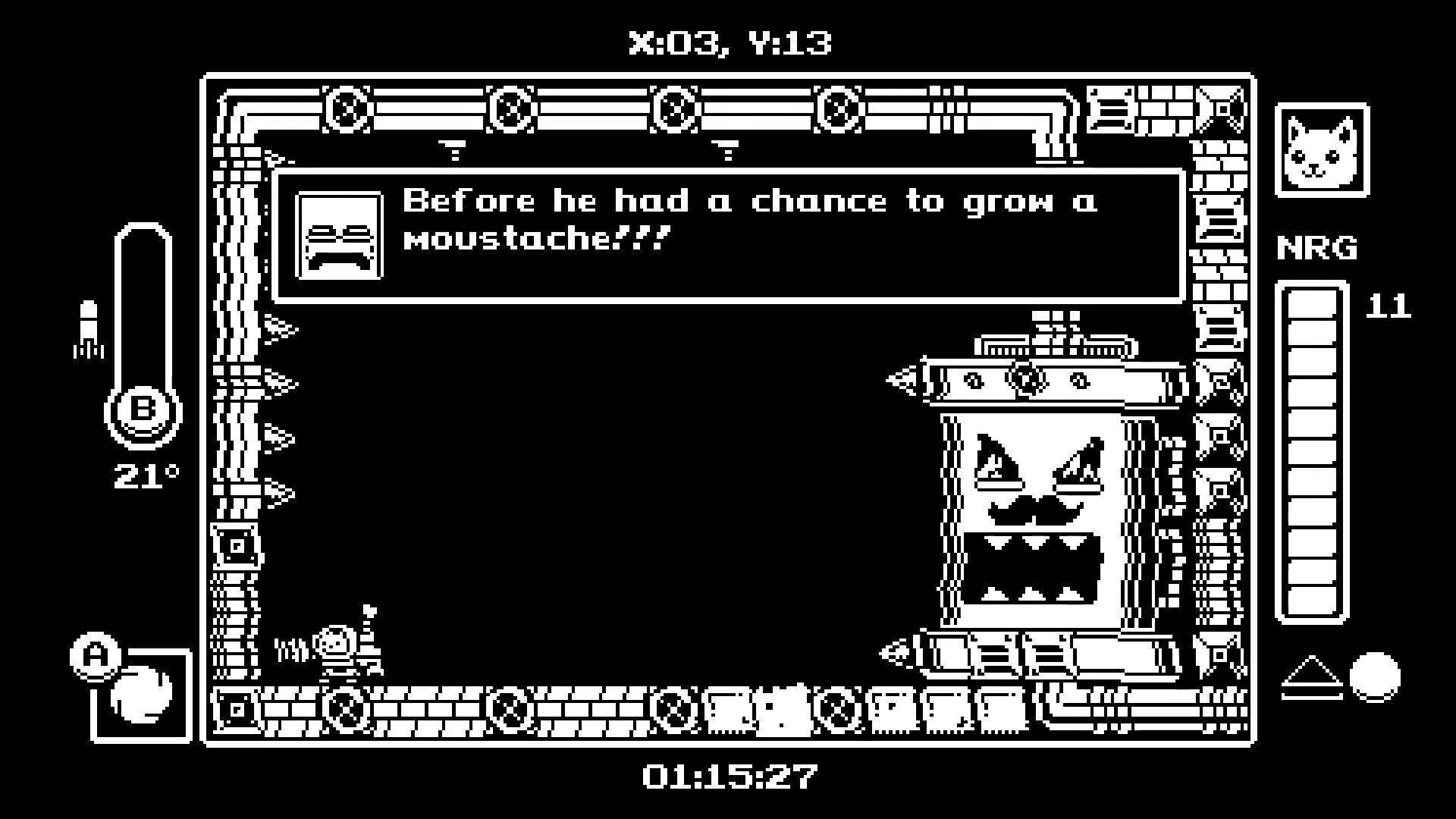
It was this joke that was the proverbial straw on my hump-like spine. Because of this joke I concluded that Gato Roboto is nothing more than an attempt to make a “funny” Metroidvania. It’s a well made Metroidvania, let me remind you, but it teeters on the edge of being generally derivative. It has great ideas, but it can’t ever stop referencing and winking at the things it likes so much 5. It would be like if I decided to once again invoke my artistic and critical inspirations for this review in efforts to prove that I can write a review. I don’t need to do that, and if I did, it would only undermine my ability to do something new with my own perspective 6. And Gato Roboto really doesn’t need to do this either! It has a fun premise! It has a well-developed set of movement physics! It has a wonderful artistic style! But it’s trying too hard to be itself in relation to its inspirations. It tries too hard to be a silly Metroidvania.
There is nothing objectively wrong with Gato Roboto as a videogame. It’s a fun, bite-sized, action platformer that is amusing to play on a room-to-room basis. It is a game that veterans to the Metroidvania genre can pick up and generally understand with little effort. It might even be a good starter game for novices to the genre. But Gato Roboto did not set my world on fire. Though in making this judgement, I have also found myself asking: “What was I hoping to get out of Gato Roboto?”. I don’t think it is fair to say that I didn’t want to play a genre-referential fourth wall-leaning Metroidvania, rather, I just wasn’t expecting to play one when starting up Gato Roboto. I liked the premise I saw on the tin, but I couldn’t have expected the tiresome “ZOMG LOOK A KITTY IN METROID WHAT WILL THEY THINK OF NEXT?!?!?!!1?”-styled approach in realizing this premise. Because that’s seriously what this game is.
And how do I know this?
Allow me to present the smoking gun:
The achievement for beating this game is titled: “Save the Animals”. 7.
One Other Gripe About the End of the Game
There’s not a cohesive way to include this in the narrative of this review, nor does it adhere to the thesis of this review, but damn it, it’s my webpage and I’m going to include it. There’s a part of the endgame of Gato Roboto that really irked me and I think it’s important anyone who plays this game knows. Like many a Materoidvania, Gato Roboto has a final stage that acts as a “point of no return”. The game makes it very clear where this point of no return is with a cheeky fourth wall break, naturally. I don’t have a problem with games doing this, actually, it’s one of the few times where I appreciate a game breaking the fourth wall in such a blatant fashion. When it comes to a “point of no return” threshold, I appreciate it when a game tells me as such in no uncertain terms. I had about 81% of the total collectables in Gato Roboto, and I figured “Okay, yeah, point of no return, that’s fine”, so I progressed. I want to emphasize, I was not expecting a clean-up after the game ended.
After the point of no return, there are additional save points, meaning that it is completely possible to lock yourself out of 100% completion, should you decide you’d rather not have to replay the final stage should you fall. Naturally, I saved the game. I’m not the most skilled gamer on the planet, I die sometimes, we exist, get over it. I also beat the final boss, so I do have some gaming skills. But whatever, I beat the final boss “Saved the animals”, and that was that. The credits rolled.
Then I returned to the main menu and found I could start my completed save file up. Thinking maybe I could get the chance to romp around the world and still do a kind of “clean up”, I booted the game up. I was then trapped in a set of rooms. One room had the dog I had saved from beating the final boss, one room had a bed, and one room had a mouse which housed Gary’s conscious after some of the body-swap shenanigans in the final encounter. I bounced around in each of the rooms, listening to Gary’s minimal speech every time I re-entered his room. Then it hit me: this was it. This was the game. There was no way to go back. I had crossed the point of no return. Again, I was not expecting a kind of clean up section after I beat the game when I initially descended into the final zone. But here, in this zone, I was left to simply exist in this perpetual state of nothingness? What is the point having these rooms at all? I never want to complain about have more game to play, but this isn’t really game at all, it’s just a holding zone for the people who beat the game. It’s just there. It’s insulting because it probably could have been easy enough to have the aplyer spawn back at the ship’s crash site instead of this. I don’t understand why the devs at DoinkSoft chose this to be the “end of the game”, and because I do not understand it, i am angery >:[
Way to leave me with a sour taste in my mouth, Gato Roboto
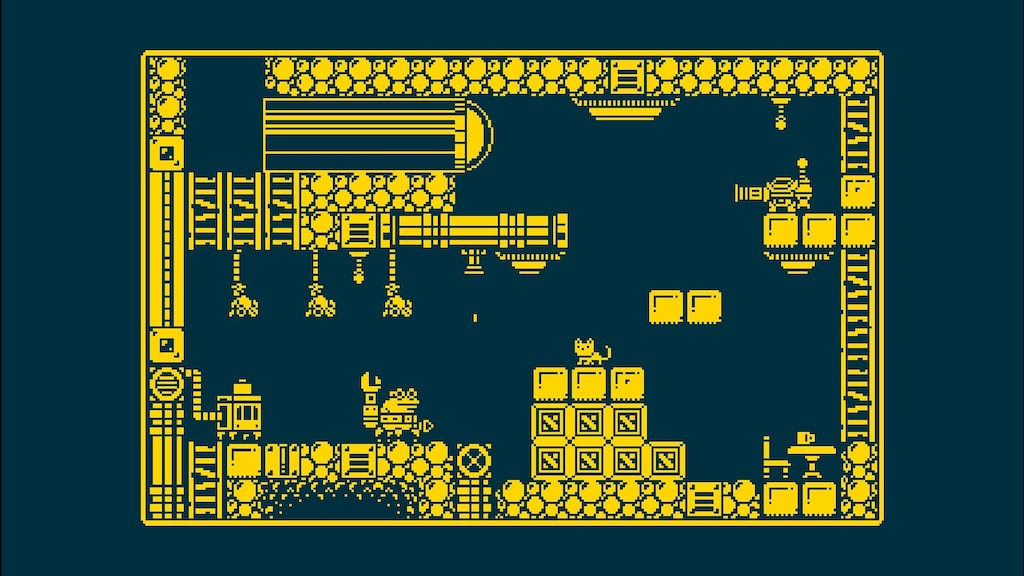
that's it buddy, you're playing with the piss color scheme
Footnotes
yes really↩︎
yes really↩︎
This design is ALL OVER Mercury Steam’s second Metroid game, Metroid Dread too. Once you notice it, you will be hard pressed to gloss over it. You do not tread previous ground in Mercury Steam Metroid games.↩︎
as described by a professor I had in my early days of graduate school↩︎
See also: See of Stars.↩︎
see also: any multi-hour video essay invoking action button, and “I HATE MARIO KART WORLD” (it’s bad).↩︎
Look, do I really need to spell out the joke? “Save the animals” refers to a joke in the Super Metroid speed running community (if not the entire community at large) where, in the final moments of Super Metroid, you can opt to take a detour to rescue the animal friends you discovered on the journey. Saving them does nothing, but it is canon according to Metroid Fusion. There’s a debate because to finish the speed run as fast as possible, it is faster to let the animals die. “Save the frames, kill the animals”. I’m a “save the animals” kind of gamer, but you won’t see me donating 5 bucks in a bid war for it. There you go, the joke explanation. Now can I please ask you to learn how to use a search engine like duckduckgo?↩︎
end matter
- I spent 4 hours playing this game.
- I spent approximately 10 hours outlining, writing, and editing the written bulk of this work.
- I spent like a half hour putting this shit all together for the website.
also fuck the hot zone boss, what a terrible time